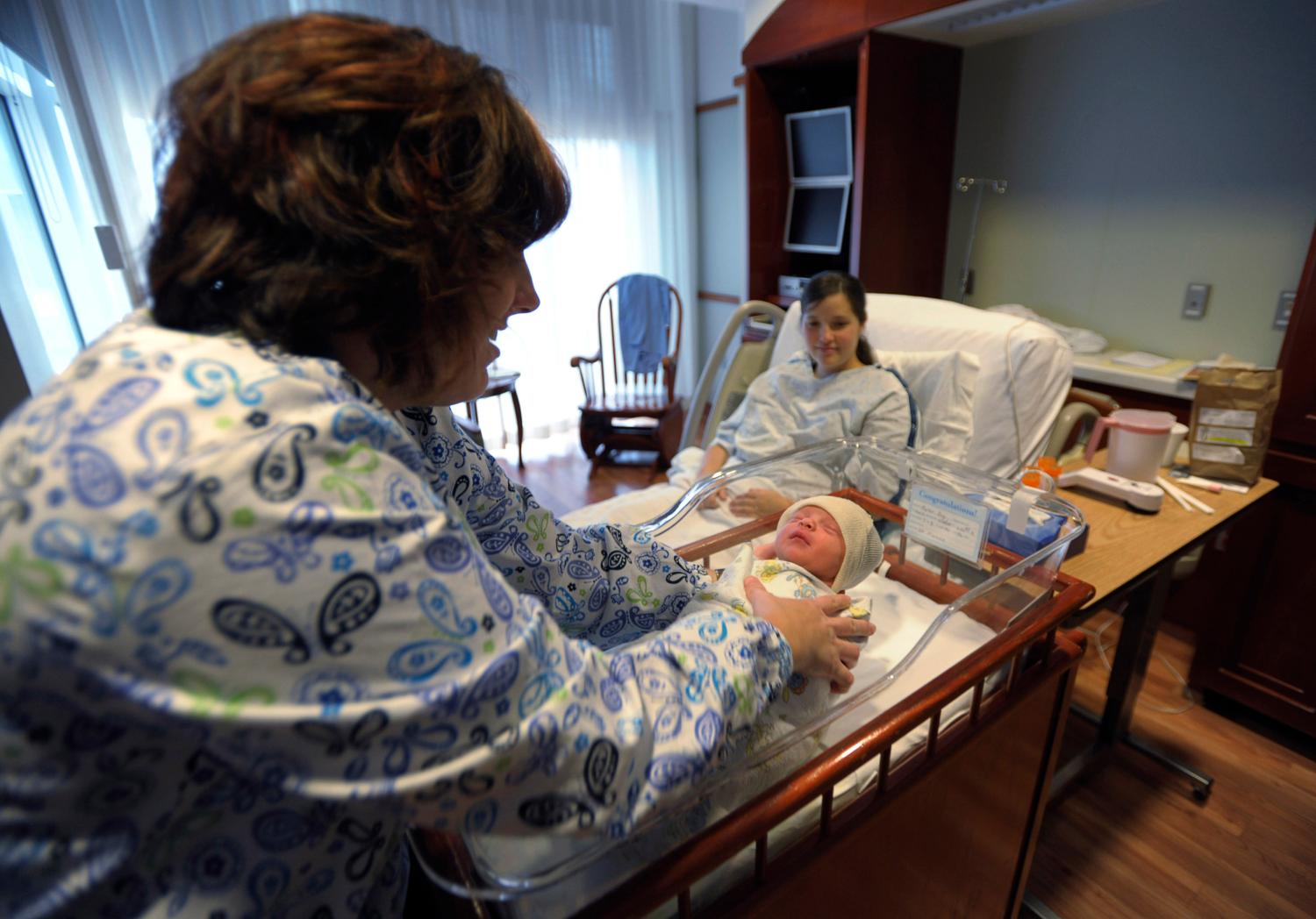Congress is poised to determine the future of one of the most innovative government programs you’ve probably never heard of: Maternal, Infant, and Early Childhood Home Visiting (MIECHV). The decision, due within the next 54 days, will signal the level of political support for home visiting in particular. But it will tell us even more about the attitude of the new Congress towards the federal government’s role in social policy in general.
WHAT IS HOME VISITING?
Let’s start with the basics. Home visiting programs consist of visits from social workers, parent educators, or registered nurses to low-income families with pregnant mothers and babies in the home. The visitors provide health check-ups and referrals, parenting advice and guidance with navigating other government programs. The programs are voluntary but ask parents to make plans and follow through with them. The visits, which usually last about an hour, vary in frequency from weekly to monthly, depending on the program and the age of the child. They often continue until the baby reaches age two, and some programs continue until the child completes kindergarten.
Home visiting is not new in the United States. Long before the federal government moved into the field, most states (46 plus the District of Columbia) funded programs, according to a 2011 survey by the Pew Charitable Trusts. The reach of these programs varied. Many states served only 2 to 3 percent of families in need. Vermont served the largest proportion: 26 percent. States like Oklahoma have been running their own programs. Others, including Texas and New Jersey, pay non-profits to run locally-grown or national programs, such as Parents as Teachers, Child FIRST, and Healthy Families America.
By 2010, US states were collectively spending around $514 million on home visiting programs. These efforts were backed by money from Medicaid, the Temporary Assistance for Needy Families block grant, the Maternal and Child Health block grant, and the Social Services block grant.
ENTER UNCLE SAM
Growing evidence for the effectiveness of some home visiting programs prompted more interest, and then more investment, at the federal level. In 2008, President Bush proposed—and Congress agreed to—$10 million for home-visiting, through a program called “Evidence Based Home Visiting” (EBHV). This was the small seed from which MIECHV grew. Between 2010 and 2014, MIECHV provided $1.5 billion to states for home-visiting.[1] The funding has brought home visiting to thousands more children. In 2010, three percent of children below 125 percent of the poverty line may have received home visits, according to the Pew survey.[2] That figure increased as MIECHV got rolling. Dr. David Willis, Director of the Division of Home Visiting and Early Childhood Systems in the Maternal and Child Health Bureau at the Health Resources and Services Administration (HRSA), estimates that since 2012 “the annual number of program participants has tripled, and the number of home visits has quadrupled.”[3] And that excludes certain additional investments by states and other entities, as well as the Tribal Home Visiting Program.
The MIECHV program included formula grants, which vary according to the number of poor children under five in a state, and competitive grants, which help states with specific projects to expand and develop their home visiting programs. In March 2014, Congress authorized an additional $400 million for fiscal year 2015. After that, no new MIECHV money will be available. The question at hand is whether the new Congress will authorize more funding.

FIVE REASONS FOR FEDERAL GOVERNMENT TO SUPPORT HOME VISITING
What are the grounds for the greater federal government involvement in home visiting? Five stand out. It is important to note that these are arguments for existing and near-term investment—they hold, whether or not you think MIECHV should become a permanent federal program.
1. Good home visiting works (as far as we can tell thus far)
Quality home visiting programs can have positive impacts on child and family outcomes. Several national programs, like Nurse Family Partnership (NFP) and Child FIRST, have been evaluated using randomized controlled trials (RCTs). A recent literature review commissioned by the Department of Health and Human Services found that 16 home visiting programs have enough support to earn the label “evidence-based.” Five of those have additionally been subjected to cost-benefit analyses. Three report net taxpayer savings, through fewer emergency room visits, lower utilization of child protective services, and increased tax revenue as a result of higher parental earnings. Benefits deriving from NFP include:
- Fewer Injuries. Participating children were 40 percent less likely to require treatment for injuries between 25 and 50 months. They were 35 percent less likely to visit an emergency room.
- Delayed Childbearing. Recipient mothers were between 10 and 20 percent less likely to have another child in their teens or early twenties. Fathers were 46 percent more likely to be present in recipient households.
- Better Test Scores. NFP children scored higher on math and reading achievement tests at age 12.
- Fewer Arrests: NFP children were 59 percent less likely to be arrested before turning 16.
- Less Welfare. Recipient families used Temporary Assistance for Needy Families (TANF) and Supplemental Nutrition Assistance Program (SNAP) less frequently.[4]


There’s also some evidence that home visiting programs work when scaled up to entire communities. One community-wide intervention in Durham, North Carolina reduced children’s emergency medical care use by half, improved maternal health, and improved parenting behaviors. For every dollar spent, the program saved three dollars in medical costs during the first 6 months of the child’s life.
 2. Bipartisan support
2. Bipartisan support
Partly because of the growing evidence for the efficacy of some home visiting programs, politicians from both sides of the aisle have seen it as a good public investment. MIECHV’s predecessor, the Education Begins at Home Act, was sponsored by former Senators Kit Bond (R-MO) and Jim Talent (R-MO) in 2004. The bill didn’t become law, but Richard Durbin (D-IL) co-sponsored it. George W. Bush and Mary Landrieu then put EBHV on the books, as our colleague Ron Haskins recounts in his recent book on evidence-based government policy. MIECHV itself had bipartisan support: Senator Bond and Senator Hillary Clinton introduced it in 2009.
3. Helps shift early years policy towards evidence
The MIECHV program has an unprecedented focus on evidence and evaluation. Participating administrators and home visiting programs must use existing research about “what works,” while being given space to develop new approaches, through rigorous evaluation. Home visiting
efforts before MIECHV did a lot of good; but they also had some flaws and raised important questions. The initiative tries to fix those flaws, answer many of the questions, and expand home visiting to a meaningful scale.
Before MIECHV, a lot of state funding went to programs without evidence of effectiveness: according to the 2011 Pew Survey, only 30 percent of available funds supported models with proven results. Almost a third of programs didn’t know how many families they served; nearly two-thirds didn’t know how much they spent per family; 44 percent didn’t track a single outcome to document effectiveness. Less than half of the spending explicitly prioritized low-income or at-risk families.
Bush’s 2008 program had a sharper focus. It sought to fund models “shown, in well-designed randomized controlled trials, to produce sizeable, sustained effects on important child outcomes such as abuse and neglect,” according to the appropriations conference report. MIECHV takes the evidence-based mission even further. First, the program required each state to conduct a needs assessment to determine which communities and demographic groups have the most at-risk children. State administrators have then used the results to target their efforts towards the neediest children. Next, MIECHV required 75 percent of funding be spent on programs with proven effectiveness, as defined by a list of models with benefits established by RCTs and/or quasi-experimental studies. To be deemed “effective” the models must improve outcomes in at least one of eight areas:
- Child development and school readiness
- Child health
- Family economic self-sufficiency
- Linkages and referrals to other services
- Maternal health
- Positive parenting practices
- Reduction in child maltreatment
- Reduction in juvenile delinquency, family violence, or crime
States can use the remaining 25 percent of funding to support innovative programs of their own creation. But, critically, they must also evaluate these programs for effectiveness. One of the barriers to the expansion of home visiting – and it should be a barrier – has been the lack of hard answers to a series of important questions. Which home visiting models actually help kids? Which pass cost-benefit tests? Are local programs executing the models correctly? If the effective programs are scaled-up, will they produce the same effects? Evaluations of four programs (Early Head Start-Home Visiting, Healthy Families America, Nurse-Family Partnership, and Parents as Teachers) are now underway to help answer these questions. As Haskins puts it: “A growing body of evidence shows that a few model social programs [including] home visits to vulnerable families…produce solid impacts that can last for many years.”
4. Building an infrastructure, sharing knowledge
States and local programs use MIECHV money to develop and expand their operations. Many of their improvements (new databases, for example) happen behind the scenes. But as Dr. Deborah Daro, a senior researcher at the University of Chicago explains, these unglamorous pieces of policy infrastructure can be crucial: “For any home visiting program to succeed, it needs to be in a context where accurate information on program participants and services is collected and shared with staff and home visitors have access to adequate training… States may not continue to make investments in its service infrastructure without a reliable and consistent funding stream; the federal funding allows states to plan.”[5]
Different states have different priorities. California, Montana, and Washington, among others, are building on earlier efforts to coordinate services between home visitors, health care providers, and early education institutions. Regular communication means less duplication of effort, and greater reach, as they develop plans to fill gaps in services. Georgia, Michigan, and Virginia, are using MIECHV money to create centralized admission systems, with help from state university researchers. Families will fill out short screening questionnaires that help home visitors identify families’ issues quicker; the families also enter a database for providers, to further coordination of services.
Some states are providing new services and improving existing services through workforce development. South Carolina has hired specialists in Cognitive Behavioral Therapy to treat maternal depression. Louisiana’s state needs assessment has revealed a lack of mental health services for pregnant mothers and kids younger than five, so they’ve invested MIECHV funds in training home visitors to address those groups. Texas evaluating how to get fathers more involved in home visiting programs. The federal money is allowing states to learn from each other, but also to be flexible in pursuit of their own priorities.
5. Helping bridge the funding gap
In terms of children served, the MIECHV expansion is both unprecedented in scale and modest in overall reach. The 2012 National Survey of Children’s Health found that, among families with children under 18, only 14 percent had received a home visit—for any of their children—before age four. But many states have now set ambitious goals: Texas and Louisiana want to reach half of all their high-risk children within 10 years.
Before MIECHV, roughly 2,200 New Jersey families received home visits at any given time. MIECHV funds have, among other things, allowed the state reach roughly 5,000 families. That’s better, although according to the state needs assessment, 12,000 families could benefit from the service. If MIECHV funds dried up, it is highly unlikely that New Jersey, or most other states, could serve so many families. Patricia Cole, director of Government Relations at Zero to Three, said “it’s doubtful the state would be able to take up all the slack; most likely, home visiting programs in New Jersey, and many other states, would have to scale back their efforts.”[6]
Texas provides a good illustration of how MIECHV supports both infrastructure investment and expansion. The state has opened new Nurse Family Partnership sites in San Antonio and Wichita Falls, which serve roughly 225 new families. Meanwhile, administrators, academics, and non-profits across the state are developing a centralized admissions system, to better meet families’ needs. Both efforts are made possible by MIECHV, which represented one of the largest sources of funding for home visiting in Texas for FY2014.[7]
Some observers might worry that MIECHV will lead to “yet another large federal program.” But that’s probably a premature fear, because the shape and form of home-visiting—and the balance of state and federal responsibility—have yet to be determined. Congress can decide that once we have the evidence.
The program was designed more like seed funding. States are required to draft “sustainability plans,” to determine how they will assume responsibility if federal funding phases out. In the near future, however, states are in a critical development period and need federal dollars to proceed: think of the federal government as the policy equivalent of a home visitor.
MIECHV: To Re-Authorize, or Not to Re-Authorize?
MIECHV’s funding will end unless Congress re-authorizes funding before the end of fiscal year 2015. Should the funding be re-authorized? Clearly money is tight. Federal dollars need to be spent with great care. But MIECHV is a worthy candidate for ongoing funding.
All the arguments made above in support of federal funding will remain true for the immediate future: the funding gap, the services for extra families, the newly trained staff, the new databases, and the development of admissions systems. We’re also waiting on the results of most of the evaluations, because they’re still underway. Some findings will become available this year. Dr. Willis offered one example of early insights: “Children in the home visiting program are more than twice as likely to be screened for developmental delays as the national average.”[8] We’ll learn about longer-term effects when the national study winds down in 2019.
Cynthia Osborne, a researcher at the University of Texas who’s helping to evaluate the state’s home visiting programs, put the stakes of reauthorization like this: “[The big questions are] ‘Are we providing effective services?’ ‘Are we spending our dollars wisely?’ I think the answer to those questions is ‘yes,’ and we’re getting better.”[9] But Osborne and others need more time to complete their evaluations, in order to inform policy going forward. Most experts believe that most programs are generally effective – but we need more completed evaluations to show which aspects work well, and which need to be modified or improved. Then government at all levels can invest with more confidence.
Federal policy programs are attacked on many grounds: that they nationalize local programs, lack bipartisan support, fail to undergo rigorous evaluation, and go to scale too quickly, while underinvesting in staff and infrastructure. These are often accurate and fair criticisms. But none apply here. In many ways, MIECHV represents federal domestic policy making at its best. Partly for that reason, more than 750 organizations have submitted a letter to Congress, urging members to reauthorize; groups from the American Federation of Teachers to the American Academy of Pediatrics have endorsed the document.
The danger is that members of Congress will not realize how high the stakes are, gain a false impression of the history and nature of the MIECHV program, and cut funding even before we get the full set of facts. If that happens, we could end up abandoning these efforts, only to learn, two years later, how well they were working.
Correction:
An earlier version of this blog said that “Texas wants to develop and evaluate AVANCE, a program designed for Hispanic families.” This was inaccurate and has been removed from the current version of the blog.
[1] Tribal organizations also received funding, as well as non-profit home-visiting programs in Florida, Wyoming, and North Dakota.
[2] It’s hard to estimate the number of children that received home visits prior to MIECHV, because states often neglected to gather basic information, like the number of children served.
[3] Dr. David Willis, Director of the Division of Home Visiting and Early Childhood Systems in the Maternal and Child Health Bureau at the Health Resources and Services Administration. Personal communication.
[4] Olds DL, Kitzman H, Cole R, Robinson J, Sidora K, Luckey D, Henderson C, Hanks C, Bondy J, Holmberg J. “Effects of nurse home visiting on maternal life-course and child development: age-six follow-up of a randomized trial.” Pediatrics 2004;114:1550-9.
[5] Dr. Deborah Daro, Senior Research Fellow at Chapin Hall, University of Chicago. Personal communication.
[6] Patricia Cole, Director of Government Relations, Zero to Three. Personal communication.
[7] MIECHV provided Texas with $19.9 million in FY2014. State funding was $14.3 million, including $2.7 million approved in 2013 for the Texas Home Visiting program, while the Nurse Family Partnership program accounted for $8.9 million. These totals omit other local and private funding, and home visiting funds from Texas’ Department of Family and Protective Services.
[8] Dr. David Willis, Director of the Division of Home Visiting and Early Childhood Systems in the Maternal and Child Health Bureau at the Health Resources and Services Administration. Personal communication.
[9] Dr. Cynthia Osborne, Director, Child and Family Research Partnership, University of Texas Lyndon B. Johnson School of Public Affairs. Personal communication.
The Brookings Institution is committed to quality, independence, and impact.
We are supported by a diverse array of funders. In line with our values and policies, each Brookings publication represents the sole views of its author(s).





